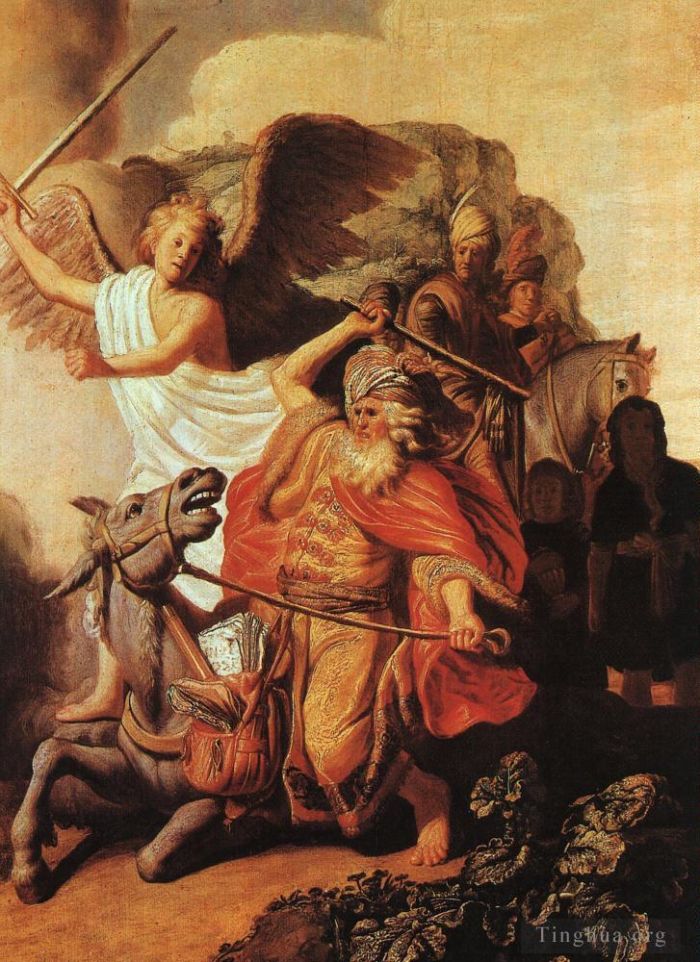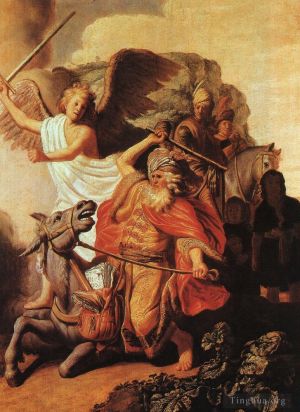Balaam and the Ass
Rembrandt
- Price: Price on Request
- Art Type: Oil Painting
- Size:
- English Comments: 0
- International Comments: 0
- Creating Date:
- Introduction and Works of Rembrandt >>
Work Overview
- Balaam and the Ass (Balaam's Ass)
Rembrandt
Date: 1626
Style: Baroque
Genre: religious painting
Media: oil, panel
Dimensions: 63 x 46.5 cm
Location: Musée Cognacq-Jay, Paris, France
Balaam and the Ass is a 1626 painting by the Dutch artist Rembrandt, dating from his time in Leiden and now in the Musée Cognacq-Jay in Paris.
It portrays the biblical account of the talking ass debating with diviner Balaam.
One of the earliest works by the young Rembrandt, who in 1626 had just set up shop for himself. This work is probably derivative of a painting by his master Pieter Lastman, be it in a truly new composition.
Balaam was a heathen prophet summoned by the Moabitean King Balak to curse Israel. On his way to Balak his she-ass refuses to walk three times because an angel blocks the road. Balaam does not see the angel and strikes the she-ass. After a third thrashing the god of the Hebrews speaks through the she-ass: What have I done to you? At which Balaam repents.
Like his masater Pieter Lastman, Rembrandt painted angels and visions. One of rembrandt's earliest paintings shows an angel interfering in human life, and it is derived from a similar work by Lastman.
The biblical story (Num. 22:1-35) represented here is the following. The arrival of the Israelites in the Jordan valley alarmed Balak, king of Moab, who sent for Balaam, a foreigner, to pronounce a curse on them. On his journey an angel, invisible to Balaam, barred the way, causing his ass to turn aside. This led to an altercation between the man and his beast in which the latter, like the animals of fable, acquired the gift of speech. Balaam's eyes were then opened and he saw the angel with a drawn sword. The conversion of Balaam by the vision of the angel was regarded as prefiguration of the appearance of Christ to the apostle Thomas.
This is one of the first known paintings by Rembrandt, the 17th century genius of the Dutch school. Its unusual subject is taken from the Old Testament. Balaam was travelling to meet the Hebrews, who were then fleeing Egypt, to curse them. However, an angel appeared twice to his mount, turning it from its course. When the angel blocked the ass' path for a third time, Balaam whipped the animal, which in turn began speaking to him. The prophet, realising the miracle he is witnessing, sees the angel and ultimately decides to bless the Hebrew people three times. This subject illustrates God's love for humanity's salvation – a fundamental principle of the Protestant faith, which had prevailed in the Netherlands since the late 16th century. Rembrandt portrays Balaam's conversion in a refined style, characterised by a painstaking technique and sophisticated colour palette. Even then, he was already placing great emphasis on light, which later became a key element of his mature work, through the dramatic impact of chiaroscuro.
- Copyright Statement:
All the reproduction of any forms about this work unauthorized by Singing Palette including images, texts and so on will be deemed to be violating the Copyright Laws.
To cite this webpage, please link back here.
- >> English Comments
- >> Chinese Comments
- >> French Comments
- >> German Comments
- >>Report
- Bathsheba at Her Bath
- The Return of the Prodigal Son
- Balaam and the Ass
- Stormy Landscape
- Christ driving the moneychangers from the temple 1626
- Young Man At His Desk
- Haesje
- St Paul at his WritingDesk
- The Abduction Of Ganymede
- Self Portrait at an Early Age 1628
- Woman in bed
- History Painting
- David and Uriah
- The Blinding of Samson
- Susanna
- Portrait Of Joris De Caullery
- Portrait of Nicolaes Ruts
- Flora
- Christ In The Storm On The Sea Of Galilee
- The beheading of john the baptist
- The Toilet of Bathsheba
- Susanna and the Elders
- Saskia in Pompous Dress
- Anna and the Blind Tobit
- Samson And Delilah
- Saskia Laughing
- Cupid Blowing Soap Bubbles
- Dead peacocks
- Self Portrait 1659
- The Holy Family with Angels
- The Artists Son Titus
- The denial of peter 1660
- The Baptism Of The Eunuch
- Repentant Judas Returning The Pieces Of Silver
- Portrait of the Artist at His Easel 1660
- Self Portrait as a Young Man 1634
- Young Woman Trying Earrings
- The Stoning Of St Stephen 1625
- Portrait Of An Eighty Three Year Old Woman
- Christ and the Woman Taken in Adultery
- Self-portrait as the Apostle Paul
- Musical Allegory
- The Artist In His Studio
- Maria Trip
- Man In Oriental Dress
- Titus at his desk
- Self portrait 1628
- The Polish Rider
- Agatha Bas
- Adoration of the Shepherds
- Young Man
- The Mennonite Minister Cornelis Claesz Anslo in Conversation with his Wife Aaltje
- Frederick Rihel on Horseback
- David Playing The Harp To Saul
- Portrait of Maria Trip 1639
- Portrait Of Amalia Van Solms
- Portrait Of A Young Woman With A Fan
- The holy family night
- The Elevation Of The Cross
- Jan Rijcksen And His Wife
- Holy Family
- Abraham of Isaac (The Angel Stopping Abraham from Sacrificing Isaac)
- The Mill
- The Risen Christ Appearing to Mary Magdalen
- The Ascension Of Christ
- Portrait of Saskia van Uylenburgh
- Self Portrait 1658
- Elder
- Portrait of Haesje van Cleyburgh
- Saul and David
- Landscape with the Rest on the Flight into Egypt
- The Conspiration of the Bataves
- Self portrait Det
- Portrait Of A Man
- The Holy Family
- Self
- Christ and St Mary Magdalene at the Tomb
- Joseph Accused by Potiphars Wife
- Artemisia
- Supper at Emmaus
- Christ Driving The Money Changers From The Temple
- The Prodigal Son in the Brothel (Rembrandt and Saskia in the Scene of the Prodigal Son in the Tavern)
- Sampling Officials of the DrapersGuild
- Danaë
- Winter Landscape
- Johannes
- JohDet
- Dr Ephraim Bueno Jewish Physician and Writer
- Saskia
- Self Portrait 1660
- Titus van Rijn in a Monks Habit
- Apostle Paul
- Samson at the Wedding
- St John The Baptist Preaching
- Portrait of Maria Trip
- The Night Watch
- Descent from the Cross
- Self Portrait 1669
- Portrait of Saskia with a Flower
- The Prophetess Anna known ass Mother
- The Man with the Golden Helmet
- David and Jonathan
- The Archangel Leaving the Family of Tobias
- Rape of Proserpina
- Portrait Of Maerten Soolmans
- Jeremiah Lamenting the Destruction of Jerusalem
- The Jewish Bride
- Christ on the cross 1631
- The Stone Bridge 1638
- Diana Bathing With The Stories Of Actaeon And Callisto
- Philosopher Reading
- Portrait Of A Woman
- The Anatomy Lesson of Dr Nicolaes Tulp
- Tobit and Anna with the Kid
- Peter Denouncing Christ
- Girl at a Window (Girl Leaning on a Stone Window Sill)
- The Raising of Lazarus
- Saskia Wearing A Veil
- Saskia As Flora
- The Visitation
- The Parable of the Rich Fool (The Rich Man from the Parable)
- Family Group
- Joseph Dream in the Stable in Bethlehem
- The Holy Family with a Curtain
- Deposition from the Cross
- Portrait Of An Old Man
- Self Portrait In A Gorget
- Portrait Of Alijdt Adriaensdr
- Slaughtered Ox (Flayed Ox or Side of Beef or Carcass of Beef)
- Portrait of Nicolaas van Bambeeck
- Portrait Of The Artist In A Flat Cap
- Philosopher in Meditation
- Self Portrait In A Plumed Hat
- The Incredulity of St Thomas
- Self Portrait 1629
- Self Portrait as the Apostle St Paul
- Two Old Men Disputing
- Aristotle with a Bust of Homer
- Belshazzars Feast
- Hendrickje Bathing in a River
- Portrait Of Maria Bockenolle
- Jacob
- Landscape with a Castle
- Portrait of Johannes Wtenbogaert
- Evangelist Matthew
- Self portrait 1632
- Portrait of a bearded man
- Self portrait 1640
- Jacob Blessing the Children of Joseph
- Portrait of a man in military costume
- The Dream of St Joseph
- Hendrickje Slapend RJM
- Portrait of Willem Bartholsz Ruyter
- In Velvet Cap and Plume SIL
- The Sense Of Sight
- Abraham Entertaining the Angels SIL
- Portrait of Willem Bartholsz Ruyter RJM
- Self Portrait 16289
- Sakia Asleep In Bed
- Study from the Nude Man Seated before a Curtain SIL
- The Blindness of Tobit SIL
- Drawing at a window
- Portrait Of Cornelis Claesz 1640
- Saskia In A Straw Hat
- Self Portrait Staring
- The Artists Father
- Ephraim Bonus Jewish Physician SIL









 Singing Palette
Singing Palette